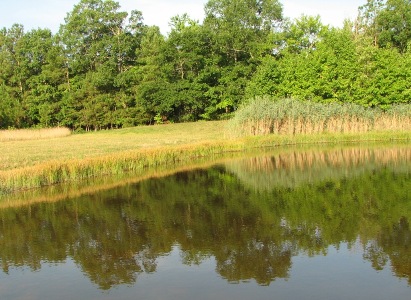When designing and constructing ponds, a variety of structural features and practices are often implemented to help sustain healthy fish populations. This article covers some of the most popular farm pond components.
Feeders are often installed in farm ponds. These devices provide a reliable source of food for fish which can greatly increase both the size and quantity of fish that a pond can sustain.
Aerators are popular in ponds. These devices help with oxygenation, water circulation, limitation of surface ice, and other problems. Full time aerators require electrical service. For less critical needs, wind powered pond aerators are available.
When possible, engineers usually include deep areas when constructing a pond. Deep sections provide safe haven in times of stress such as extreme cold or when oxygen depletion occurs near the surface.
Areas with gentle slopes from the shoreline are extremely important when constructing ponds. These areas provide habitat for forage species as well as areas for spawning and nesting.
During periods when water levels are low, these structures provide vital refuge for young fish and forage species. When these areas have southern exposures, they warm considerably on sunny days.
Brush piles can be beneficial, especially when populations of panfish such as crappie or bluegill are desired. Brush piles and downed trees provide simple, natural sanctuaries for fish and other wildlife.
Occasionally, pond owners install artificial fish attracting devices (FADs). These include floating, suspended or sunken devices. FADs work by offering shade, shelter, or simply by attracting fish that are curious.
Spawning and nesting areas are crucial when designing and constructing man made ponds. These usually include shallow areas with an abundance of gravel or sand.
Trees and shrubs can play a vital role in the success of ponds. Trees that grow along the shoreline offer shade, food and cover.
Submerged aquatic vegetation (sav) is essential for most ponds. Vegetation provides shelter for plankton and other small pond inhabitants, which in turn, helps feed young fish. Vegetation also produces oxygen, which is essential for fish populations.
Some ponds support colonies of water lilies (spatterdock). These plants provide excellent cover for predator species as well as forage fish. Lily pads also attract insects, aquatic invertebrates, amphibians, and other pond life.
Some design aspects such as depth, grading, and bottom contours must be chosen during the design phase and implemented during initial construction. Other pond components such as aerators, shoreline vegetation, brush piles, and other structures can be added after the construction phase.
